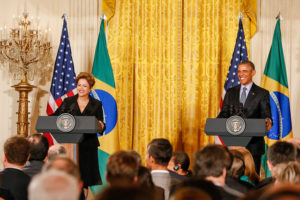Sales exploded in the Brazilian automotive market during the global financial crisis when the government incentivised car ownership by cutting a tax on industrialised products (IPI), prompting at least 10 Chinese manufacturers to open factories in Latin America’s biggest market. But in late 2014 President Dilma Rousseff exacted an economic policy shift. The result: demand has declined after years of strong sales and new investments in industrial units.
Chinese manufacturers JAC Motors, Effa, Chery, Rely, Jinbei, Hafei, Lifan, Byd, Changan, and Geely all have factories in Brazil, with JAC Motors and Chery having more advanced operations. But despite their affordability, Chinese brands are strugling to establish themselves in Brazil as growth has slowed to a standstill and increasingly strict rules for domestic manufacturing have been introduced, including restrictions on pollution.
One of Brazil’s top energy research institutions, COPPE-UFRJ, expressed concerns about the effects on the environment of government incentives to stimulate demand for automobiles. “In a scenario in which the government is benefitting companies, it is important that these are accompanied by countermeasures aimed at increasing fuel efficiency in vehicles,” a COPPE-UFRJ study co-authored by Greenpeace said. It also stressed that when the Brazilian government did slash the IPI tax during the global financial crisis in 2008 without requiring countermeasures from car manufacturers, it missed an “excellent chance to start a bold program to increase energy efficiency”.
With 86.7 million vehicles (47.9 million of which are automobiles) on the road in Brazil, the country faces serious air pollution problems resulting from transport emissions – fossil fuel-powered vehicles cause 95% of air pollution. Data from the Brazilian Ministry of the Environment’s National Inventory of Vehicular Emissions shows that cars are still the major air polluters in big cities, despite the implementation of programs to control transport pollution.
One such control is the Program to Control Motor Vehicle Air Pollution (Proncove). This program has been in force since the beginning of the 1990s; it stipulates the use of catalytic converters and fuel vapor-trapping devices in new models, and in 2014 forced the removal of outdated lines of engines that do not meet pollution and emissions limits.
According to a report from the Organization for Economic Cooperation and Development (OECD), by 2050 pollution from particulate matter and ozone will be the leading global cause of death related to the environment. In 2011, air pollution was responsible for the deaths of two million people worldwide (65% of these in Asia), a jump of more than 200% from the 800,000 victims registered ten years previously.
Falling sales, lower fuel-efficiency
According to the Brazilian Association of Motor Vehicle Manufacturers and Importers (Abeifa), the total number of vehicles purchased and registered in February 2015 fell 22.9% compared to January (from 7,478 to 5,764), and 32.5% in comparison with February 2014, when this number stood at 8,544. And this is happening at a time when the country faces a serious economic problems, with high rates of inflation (at 8% over the past 12 months), the national currency devalued against the dollar, elevated interest rates, and a drop in the consumer confidence index.
But falling sales means fewer new cars on the road, cars that are more fuel-efficient. And the government program introduced in 2012 that was designed to stimulate demand, Inovar Auto, also included targets for fuel-efficiency.
Inovar Auto describes itself as being designed to “create the conditions to increase competitiveness in the automotive industry, produce more economical and safer vehicles, invest in the supply chain, in engineering, in basic industrial technology, research and development, and qualification of suppliers”. The program will run until 2017.
Inovar Auto also included a discount of up to two percent off the IPI for companies that improve efficiency levels to 1.82 MJ/km, which would correspond to a 12% improvement on 2011 levels. This discount would be valid between 2017 and 2020 and would be progressive in nature: two more percentage points would be discounted for vehicles with efficiency levels of 1.68 MJ/km, an overall improvement of almost 20% and equivalent to European fuel efficiency targets.
“We’re very comfortable with this incentive to search for new technologies, because even before Inovar Auto was drafted, we already planned to install a research and development center along with the factory,” said a representatives of JAC, which will soon set up its factory in northeastern Brazil.
Brazil is experimenting with a variety of makes and models of car to suit all tastes and wallets. As part of the Brazilian policy to favor domestic manufacturing, the government decided to put the brakes on imports by raising the IPI tax, already one of the most significant in the market, by 30 pecentage points. But the levy did not apply to car manufacturers that signed up to Inovar Auto.
ABEIFA expects that the first half of the year will continue to be difficult for manufacturers, since the performance of car companies is associated with macroeconomic indicators; and they suspect that these will not improve for a while. “Any comment about a reaction in the market is very premature,” states Marcel Viscount, president of ABEIFA. The combination of high supply, lower incomes, and a stuttering economy has resulted in poor sales.
But Luis Curi, Vice President of Chery Brazil, is not put off by the country’s poor economic performance; “the Brazilian automotive market is seen as a priority for Chery, which is investing for the first time in an automotive plant that is 100% outside China.”
Chery sold 9,547 vehicles in Brazil last year, 1,522 more than in 2013.




